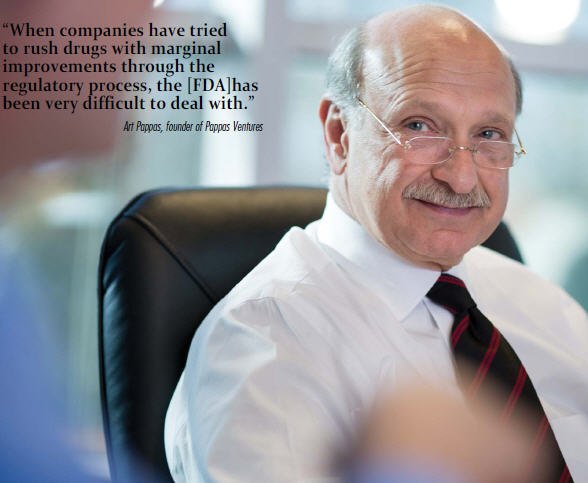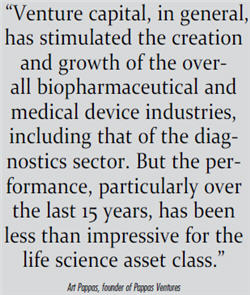Adaptive Funding: Survival Of The Fittest In The Life Sciences Start-Up Evolution
By Wayne Koberstein, executive editor
A conversation with veteran VC Art Pappas explores emerging investment options for new life sciences companies.

Evolution, like democracy, is a crazy system but it’s the best one we have for its purpose: adaptation. As living organisms, we have arrived at our present adaptive state with a collection of often wondrous yet imperfect tools of survival. So you can look at the evolutionary progress of life sciences start-ups as either a miracle or an utter mess. But if you focus on the inevitable contribution of natural selection over time, you can mainly and optimistically expect the fittest companies — those that have a solid concept and are prepared to prove it — will survive.
And the present seems to be a good time for optimism, with biotech IPOs in a remarkable boom, as well as new funding pipelines opening up to fill the gap left by venture capital’s retreat from early-stage deals. So goes at least part of the story we hear from Art Pappas, founder of Pappas Ventures and a seasoned veteran of life science investment. Pappas sounds primarily upbeat about the emerging options for an industry made largely of start-ups and venture capitalists.

“We’ve seen an appropriate culling of the industry in the number and size of funds, as well as the number of science projects versus true sustainable enterprises, after a period where excellent investment returns were dampened by poor product performance and regulatory hurdles,” Pappas says. “Now we’re seeing an unbelievable pipeline of exceptional medical discoveries being developed in a regulatory environment that is much more transparent and predictable for investors, where we can count on survival of the fittest.”
Pappas Ventures is not the largest fund in life sciences, but it is one that exemplifies VC survival and success through the perilous times the life sciences sector has been facing. Pappas founded his firm in 1994 to invest solely in biotechnology, biopharmaceuticals, drug delivery, medical devices, and related life science ventures. The firm now manages more than $350 million in capital and claims credit for “launch and/or development” of more than 50 companies, such as Arena, Chimerix, Peninsula, Plexxikon, and Tesaro. Pappas and his partners remain bullish but highly selective in funding early-stage companies and products.
THE STATE OF VENTURE CAPITAL
This is where I’m supposed to tell you how awful the VC climate for biotech has become. But of course it isn’t that bad, as the VCs themselves well know. I had read through most of the PwC report on life science deals in Q1 2013 when I spotted it — yes, overall life science VC activity dropped 28 percent in dollars and 23 percent in number of deals from Q1 2012 to Q1 this year. But the human biotechnology sector actually rose 1 percent in the same period. Medical devices also fell as a whole but had some growth in the medical/ health products subsector.
boom of 2013, with more than a dozen life sciences companies going public successfully and VCs putting about $1.3 billion more into the sector than they had in the previous quarter. Was this all paper headlines drifting in the prairie wind? Or does the surge in funding relate more to fundamentals — a general healing of the macro economy, the return of “specialist” industry-wise investors, and the de novo participation of a fresh crop of “generalist” investors and funding sources? Pappas simply welcomes all comers.
“The industry itself is in a bit of flux, maybe in a bit of a crisis,” says Pappas. “Venture capital, in general, has stimulated the creation and growth of the overall biopharmaceutical and medical device industries, including that of the diagnostics sector. But the performance, particularly over the last 15 years, has been less than impressive for the life science asset class.”
Pappas has a credible perspective on shifting times and trends — arguably, a sanguine view you can only obtain through sufficient years and experience. The broader sense of accomplishment tempers how he views investment highs and lows. “Even though the industry is in flux, I don’t see it as an overall bad place. Funds have resized themselves so, at least at this juncture, the right amount of capital is there to move some of the new technology and products forward. The limited-partnership investor base has become much more sophisticated and better understands the asset class, as well as the importance of investment in innovation from a societal and an economic perspective.”
SURPRISING BONUS? REGULATORY ACCELERATION
A large part of the credit for the sunnier investment climate goes rightfully to the industry’s regulators. A spike in product approvals, especially by the FDA, as well as the agency’s aggressive use of priority reviews and accelerated approvals, has put the spotlight on novel therapies and diagnostics for unmet medical needs. In many cases, new investors have rushed into the sector without much information to distract them. But the prospect that the high approvals rate will continue has also drawn former funders back to the fold.
Pappas believes the surge of approvals signals more than a change in FDA policy — and that companies have also brought more to the table. “Where there is unmet medical need, the FDA has been the most cooperative, the most transparent, and the most predictable for companies developing new drugs,” he says. “But when companies have tried to rush drugs with marginal improvements through the regulatory process, the agency has been very difficult to deal with.” He cites oncology as one area where developers of innovative drugs addressing a clear medical need have received strong support from the FDA.
Oncology has also gotten a boost of late from the FDA’s cancer czar, Richard Pazdur, whose office had once grown infamous for its multiple refusals to approve new drugs. Pazdur gets little flack these days when he says the new approved therapies are superior to past candidates and NDA (new drug application) submissions have also improved.
Beyond oncology, drugs for treating orphan diseases have been the leading model of the FDA’s support for “unmet need” therapies, largely because orphan drugs enjoy a natural base of support and a dedicated regulatory pathway based on need in small populations. Orphan drugs bear a close relationship, and often overlap, with personalized medicines, which have received some criticism for creating tiny commercial segments while escalating prices to unprecedented heights.
But Pappas perceives a larger value to the personalized medicine strategy. “So-called ultrasegmentation requires the developer to go through the FDA and the payer processes in a way that confirms MoA (mechanism of action) and PoC (proof of concept), usually in a smaller trial with a very targeted base. In time, the discipline of personalized medicine will be seen as a favorable approach to developing medicines for broader areas as well.”
Along with the regulatory breakthroughs, Pappas also sees other strengths emerging among young companies and their funders: “The Darwinian element is playing out on a number of different fronts. All of our companies have become more capital-efficient — the whole industry has become more capital-efficient. And the chance to have this kind of constructive dialogue with regulators about very novel and unique medicines, just by definition, has made it easier to speed their progress through review. The FDA has realized it needs to give us better clarity and predictability as we start new trials.”
FINDING FUNDS IN ALL THE RIGHT PLACES
Downturns naturally precede turnarounds, and there may be a large cyclical component of the latest upsurge in life science investment, but also perhaps some unique elements. One possible benefit of VC flight from the industry is the creative response of companies that had to look elsewhere for funding support — thus giving rise to new, nontraditional funding mechanisms often customized to each company. Limited, semipublic offerings, biodefense grants, philanthropic funds, and corporate capital groups such as GSK’s SR-One have become some of the more widely employed vehicles for filling the funding gap.
According to Pappas, such groups have not only supported small-company innovation, but have done so at only a marginal cost to the pharma companies that support them. “The estimated amount of cash Big Pharma had on its balance sheet in 2003 was about $70 billion; today, it’s around $130 billion. If we added up all the corporate VC funds, including their overhead and infrastructure costs, it would be a very small fraction of that cash amount. All of those corporate VC efforts are primarily off balance sheet and clearly an effective business and R&D development approach.”
As corporate VC groups have entered the scene and grown in sophistication, another new source of funding has emerged in parallel: venture philanthropy. Not only have the philanthropy groups increased in numbers and size of funds, but they have also enlarged their roles in the entire process of drug discovery and development, Pappas explains. “Venture philanthropy does three things: one, provide funding; two, provide access to patients; and three, provide access to physicians in the disease space. So if you have a drug or treatment approach that no one has pursued before, the philanthropists can be extremely helpful.”
Accelerators or incubators have proliferated as a way to support life sciences start-ups and attract companies into local economies. Pappas believes the jury is still out on the question of whether such entities will ultimately make money for investors, but says he is seeing some better quality programs come out that are more capital-efficient. But these days, he believes the most effective industry-boosting action in the United States is happening at the federal level, namely with new NIH programs, DARPA, and most recently the JOBS (Jumpstart Our Business Startups) Act.
 “We encourage all of our companies to make sure they’re effectively looking at NIH, DARPA, and all similar organizations and programs, particularly if they are not going to use venture dollars. Those programs have been there for a while and do continue, particularly in the major areas, and we advise companies to pursue them as needed.”
“We encourage all of our companies to make sure they’re effectively looking at NIH, DARPA, and all similar organizations and programs, particularly if they are not going to use venture dollars. Those programs have been there for a while and do continue, particularly in the major areas, and we advise companies to pursue them as needed.”
By some provisions in the JOBS Act, companies below a certain size can forego some disclosure requirements and negotiate with investors confidentially. “The JOBS Act is giving companies an opportunity to tap into the capital markets in a way that we haven’t seen in over a decade,” Pappas says.
Besides and before the confidential JOBS Act filings, and as an alternative to the traditional S1 IPO, companies have been making use of the cluster of “Form 10” SEC filings to set up reverse mergers, essentially by turning a public company into a shell. An updated Form 10 issued in 2008 allows a new twist on the reverse merger, different from a typical S1 or a JOBS Act filing.
Company investors prepare and file an S1, advising the SEC that the company plans to go public. Then the investors put a small amount of money, say $500,000, into that vehicle and take it public, using primarily a retail base to buy the stock, which creates a tradable security as a pink-sheet listed company. The company then uses the appropriate SEC regulatory process to bring in large institutional investors to hopefully buy the public stock. The SEC will review the S1 again as an already-filed public document.
But Pappas doubts the practice will significantly grow. He has not seen a lot of new Form 10 filings come forward, primarily because the JOBS Act has become so attractive and the absolute costs for the traditional IPO, a JOBS Act IPO, or Form 10 IPO are exactly the same. He believes there may be less interest in the Form 10 route and more movement toward the JOBS Act, and when a company has an especially unique proposition, it should proceed under a standard IPO. Yet he says it is fundamentally important to see these new and various instruments come forward because they are providing attractive alternatives for financing life sciences companies.
Whatever the alternatives, all of them together are unlikely to fill the gap left by VCs since their life science heyday. Despite even the current upsurge, many new companies will still wander into the veritable Valley of Death, often to meet the final fate its moniker implies. But Pappas sees the valley more as a filter than a fatal furnace: “The Valley of Death is not a bad situation to have. It helps sort out the science projects, which may be better done under the purview of the NIH and until they get to the point of true translational medicine, where they can define a plan to effectively pursue mechanism-of-action, proof-ofconcept, and a financially sustainable business model.”
SOURCING FUNDS — AND STABILITY
Whether the recent surge in biotech IPOs and VC cash proves to be a lasting boost or transitory bubble for early-stage investment, the full lessons of the past would favor an adaptive funding model. Young, fragile companies need ways to insulate themselves from boom-andbust cycles by diversifying their funding portfolios to tap sources that don’t flood in one season only to vanish with the rains in the next. Even the strongest organism can rapidly perish if it depends entirely on a single element of its environment and the element suddenly disappears. Tiny foragers persist where the dinosaurs fall.
Time is the real commodity purchased with investment money. Time to do the right work — formulate the compound, interrogate the toxicology, prepare to test in people, recruit patients and investigators, and run even the most elementary Phase 1 trial — all the work necessary to attract more capital, a partnership, or an acquisition to advance the drug toward legal sale for use in medical practice.
At a minimum, the young company must survive long enough to prove its concept. To fail proof-of-concept in a fair scientific test is regrettable, but not nearly so much as failing to achieve proof-of-concept because there is insufficient money in the bank to pay for testing it. In such cases, the lost-opportunity costs for the company, the industry, and society remain as unknown as an unresolved tragedy in the true sense.
